Pre-Columbian Murals and Norse Sagas Suggest Vikings Met the Aztecs, and the Outcome Was Not Pretty
Did the Vikings visit Pre-Columbian Mexico? The depiction of white people on Chichen Itza murals in the Temple of the Warriors probably represent Vikings - the major European navigators around the time this temple was built. This suggests the tradition of the “White Lords” who had visited Mexico before the Spanish were the Vikings.
Norse Sagas Discussing Voyages that May Have Landed in Mexico
Hans Ebeling published the book ‘ Die Reise in die Vergangenheit III. Die Europäer gewinnen den Erdball. Geschichte der Neuzeit bis’, in 1789. In his text, Ebeling talked about how Moctezuma II welcomed Hernán Cortés as Quetzalcoatl. Guðrún Guðmundsdóttir and Björn Thorsteinsson translated Ebeling’s book into Icelandic. They discussed the Eyrbggia saga in the epilogue. This saga mentions two possible Vikings who may have sailed to the Yucatan region of Mexico - Gudleif Gudlaugson (c.1025 AD) and Björn Breiðvíkingakappi (c.965).
Guðmundsdóttir and Thorsteinsson claim that the Eyrbyggja saga describes how Björn Breiðvíkingakappi (Björn the champion of the Broadwickers) sailed around Ireland and landed in Mexico.
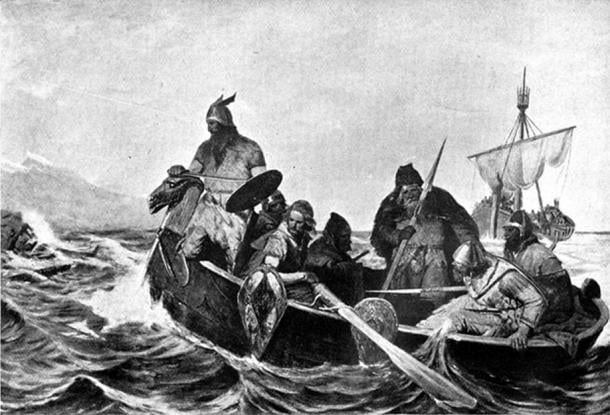
Drawing of Norsemen in a ship by Oscar Wergeland. (Public Domain)
There are also three traditions of the Norse Sagas that mention that in 965 or 986 Ari Marson set sail from Ireland in an attempt to reach Greenland. The story has it that Marson’s ship ran into rough seas and a storm threw him off course. Within six days he had reached Mexico instead. The Eyrbggia saga and the voyage of Ari Marson may explain how the first white people got to the Yucatan.
- Mystery Settlers Reached 'Step to Americas' Before Vikings
- Remote Sensing Satellite Uncovers Astonishing New Evidence of Viking Presence in Newfoundland, Canada
- The Tecaxic-Calixtlahuaca Head: Evidence for Ancient Roman Transatlantic Voyages, a Viking Souvenir, or a Hoax?
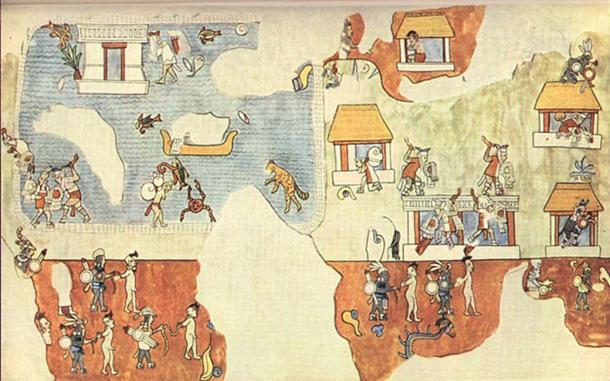
Mural in the Temple of the Warriors, Chichen Itza, Mexico. The image shows light-skinned men as they pack to retreat by sea, while others defend a village or are taken away as prisoners. (The Plumed Conch)
The White Lords’ Return
Many researchers claimed that tens of thousands of indigenous peoples helped Hernán Cortés conqueror the Mexica (Aztecs) in 1519. They formed a confederation of a number of disparate peoples who wanted to throw off the Aztec yoke.
Some researchers claim that the tribes joined the conquistadors’ in defeating the Aztecs because they represented a return of the “white lords”. However, most researchers say that this story about “white lords” was a myth created during the Spanish conquest. Restall wrote that: “The legend of the returning lords, originated during the Spanish-Mexica war in Cortés' reworking of Moctezuma's welcome speech, had by the 1550's merged with the Cortés-as-Quetzalcoatl legend that the Franciscans had started spreading in the 1530s.”
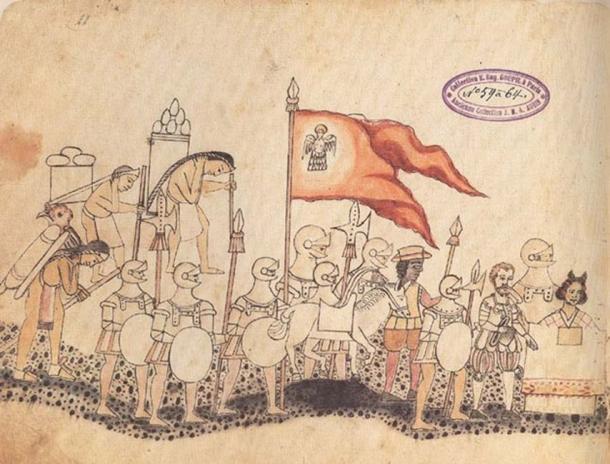
Codex Azcatitlan page depicting the Spanish army, with Hernán Cortés and Malinche in front. (Public Domain)
But this story of “white lords” in Pre-Columbian Mexico may make sense. The Temple of the Warriors in Chichen Itza suggests that Europeans had visited Mexico between 600-900 AD. Murals in the temple depict black, white, and brown people. In some of these murals one can see whites fighting and in bondage to blacks.
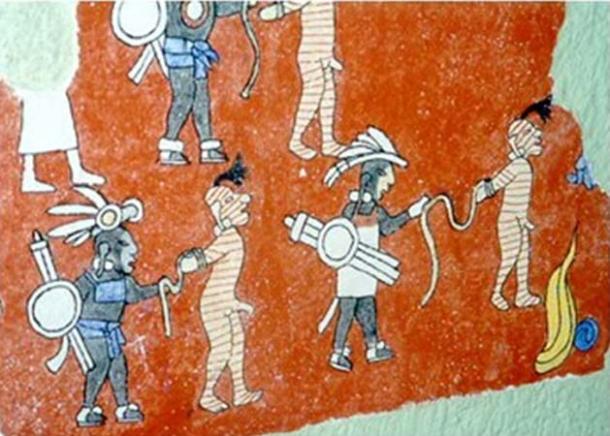
White prisoners in bondage to blacks. (In the Cavity of a Rock)
The Complex Dance of the Giants
In Esotericism of the Popol Vuh by Raphael Girard, one reads about the ‘Dance of the Giants’. This Mayan dance appears to represent a Pre-Columbian conflict between white and black people in Mexico.
This book is quite illuminating. In it, Girard discusses the Dance of the Black Giants. The dance of the Black Giants explains the reason why the other indigenous peoples joined the Spanish in destroying the Aztec nation. Girard's description of the Dance of the Giants is startling. He wrote:
“In the following episode, Apparition, the vicissitudes undergone by the White Giant, who has fallen into the hands of his rival, are mimed. The Black Giant "intimidates" his opponent by beating the ground furiously with his sword while he makes menacing gestures and movements in hopes of touching or wounding the White Giant, who defends himself as best he can by trying to evade and riposte the thrusts. The battle is suspended at intervals while the giants pay homage to the sun, but is then immediately resumed with greater fury. During the whole episode the Black Giant maintains a menacing stance, not only toward his rival but also toward the large audience witnessing the spectacle. Both actors watch each other constantly, trying to take advantage of the smallest error of the other. For whole minutes they are motionless like statues, then cautiously cross swords as they dart glances around in all directions as if fearing some invisible danger. Then they come to grips and each places the point of his sword against his opponent's neck, a tragic pose that lasts but an instant. Finally the Black Giant succeeds in decapitating the White Giant "because his power is greater," an episode that for the Chortí represents the moment "when our Lord was suffering under the dominion of the bad spirit.”
The defeat of the white giant by the black giant is not the end of the dance. In the Dance of the Giants a white person called Gavite returns to Mexico and helps the indigenous peoples defeat the black giants. Girard explains:
“Finally, Gavite decapitates the Black Giant and takes away his sword, after the giant humbly says to him: "Rest a moment, child, and I will give you your payment, because I now yield myself, and even my heart trembles." He acknowledges himself vanquished and a tribute-payer to Gavite from thenceforward. But the hero-god replies: "There is no rest now, boastful giant, because we are beginning the end of the labor [hornada]." We note here for the reader's better understanding that the word hornada means task, act, or ceremony, and is a term frequently employed by Chortí elders in that sense.”
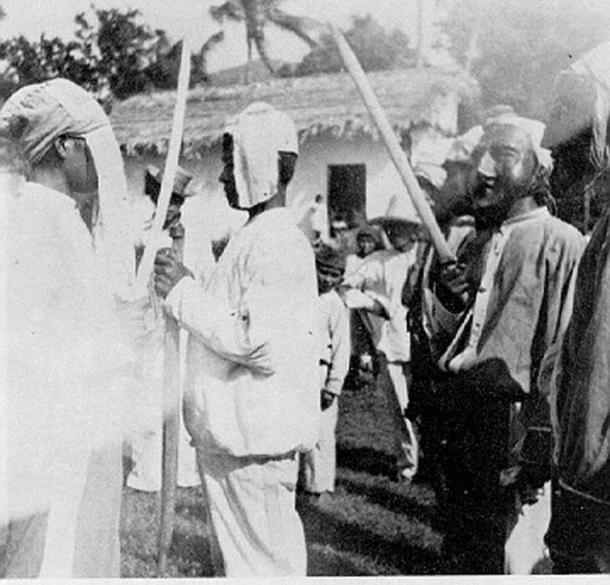
Scene from the traditional ‘Dance of the Giants’ showing Gavite and the Black Giant, amongst other characters. (Theosophical University Press Online Edition)
Girard continues the tale:
“There is no discrepancy between the Chortí and the Quiché sources regarding the manner of killing the chief of the infernal forces. Gavite cuts off his head, just as Hunahpú did that of Hun Camé in the Popol Vuh: "The first to be cut off was the head of the one called Hun Camé, the great Lord of Xibalbá." Offering the Black Giant's head and sword as trophies to the King and Captain, Gavite says: "Here I bring you the head of this giant, with a blade of steel from my sling, from my battle. It will overcome the whole world, since if you do not subdue it, it will be your subduer.”
The Chichen Itza mural indicates that the indigenous peoples had sided with the blacks when the whites first attempted to invade Mexico. However, it later appears that they felt the ‘black giants’ were arrogant and boastful and they wanted to overthrow them – even though they originally had helped defeat the Vikings.
- Did Ancient Egyptians Trade Nicotine and Cocaine With the New World?
- The Controversial Origins of the Maine Penny, A Norse Coin found in a Native American Settlement
- Scientist explores connection between Shang Dynasty China and ancient Peruvian cultures
The Dance of the Giants probably represents the fight between the whites and blacks for power. The whites lost the first battle (as depicted in the murals at Chichen Itza) but the Maya people were used as pawns by the blacks to defeat the whites. In one of the murals one can see a blond-haired man being sacrificed by two black men.
A part of a mural showing a blond-haired man being sacrificed by two black men. (In the Cavity of a Rock)
Describing the Aztecs
Although many of the Indigenous peoples sided with the blacks in their battle against the white invaders in Pre-Columbian times, by the time the Spanish arrived in Mexico the black rulers, namely the Aztecs, were mistreating the other groups of Indigenous peoples.
The Spanish described the Aztecs as follows: “The people of this land are well made, rather tall than short. They are swarthy as leopards, of good manners and gestures, for the greater part very skillful, robust, and tireless, and at the same time the most moderate men known. They are very warlike and face death with the greatest resolution.”
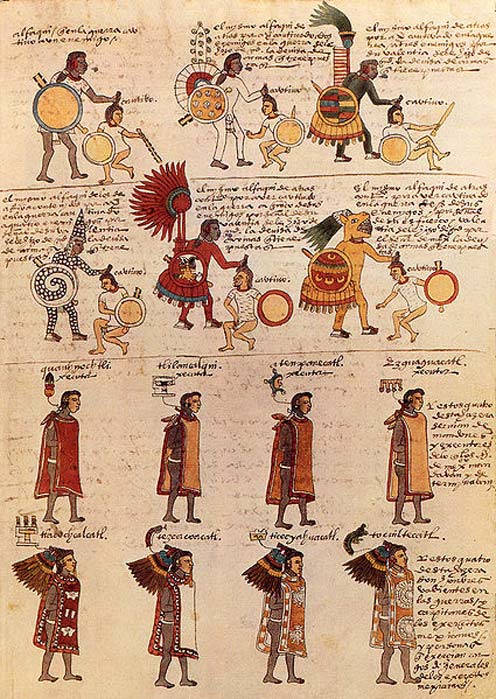
Folio 65r of the Codex Mendoza, a mid-16th century Aztec codex. (Public Domain)
Archaeological evidence, Mayan and Spanish descriptions, and pictorial evidence from the codices indicate the Aztecs may have been black people. This would not be surprising because the Paleo-Americans Luzia and Naia were also black.
In addition to the Spanish describing the Aztecs as black ‘like leopards and jaguars.’ The Mayas called the Aztecs xilaan “curly or frizzy hair”, which is characteristic of Sub-Saharan Africans. Furthermore, one can find Black/Negro/African people in the Mexican codices, including the Codex Telleriano and Codex Mendoza.
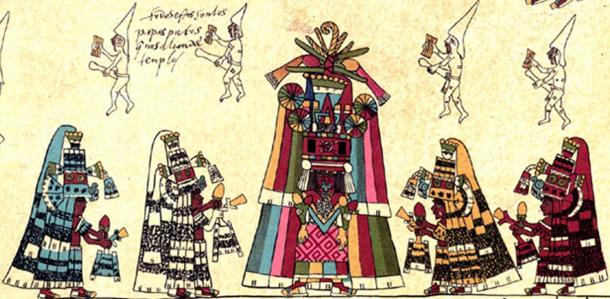
Detail of page 30 of the Codex Borbonicus. (FAMSI)
Connecting the Dots
In summary, it would appear that the character named Gavite in the Dance of the Giants represents the Spanish. The blacks defeated by Gavite were the Aztecs, who were identified by the Maya and Spanish as black and were represented in the codices as a horrible people who mistreated the other local tribes.
The whites who landed at Chichen Itza were Vikings. The Vikings were well-known navigators that sailed to many nations in Europe, including Great Britain. They may have been sailing in the Atlantic and were mislaid by a storm until they reached Mexico.
As Dennis Tedlock notes in Popol Vuh: The Mayan Book of the Dawn of Life: “They didn’t know where they were going. They did this for a long time, when they were there in the grasslands: the black people, the white people , people of many faces, people of many languages, uncertain there at the edge of the sky” (pp.149-150). This mention of whites and blacks in the Popol Vuh supports the diverse populations depicted in the Chichen Itza murals.
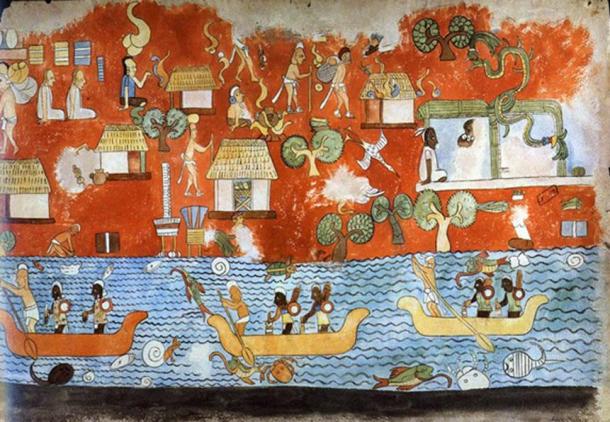
A mural from the Chichen Itza Temple of the Warriors. (Copyleft)
Top Image: Detail of a mural from Chichen Itza’s Temple of the Warriors. Source: Celticnz
References:
Raphael Girard, Esotericism of the Popol Vuh, Chapter 15. http://www.theosociety.org/pasadena/popolvuh/pv-hp.htm
Restall, Matthew (2003). Seven Myths of the Spanish Conquest. Oxford and New York: Oxford University Press.
POPOL VUH: THE MAYAN BOOK OF THE DAWN OF LIFE, translated by Dennis Tedlock. http://www.abualsoof.com/inp/upload/pdf/THE%20MAYAN%20BOOK%20OF%20THE%20DAWN%20OF%20LIFE.pdf
Þórunn Valdimarsdóttir, Vikings in Mexico 998 AD? http://thorvald.is/?page_id=392















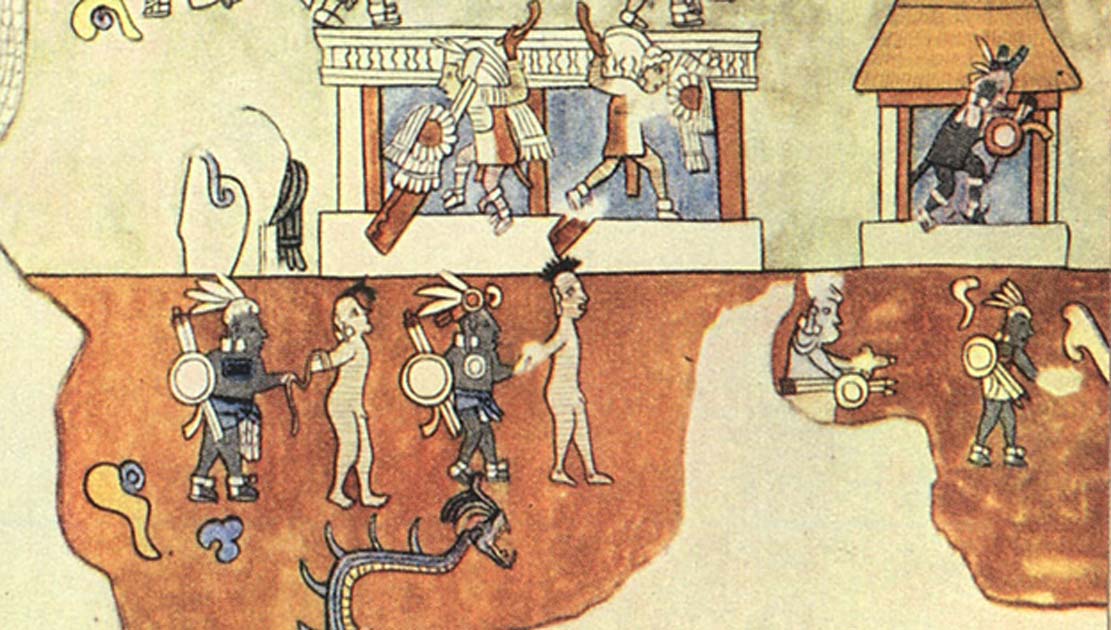
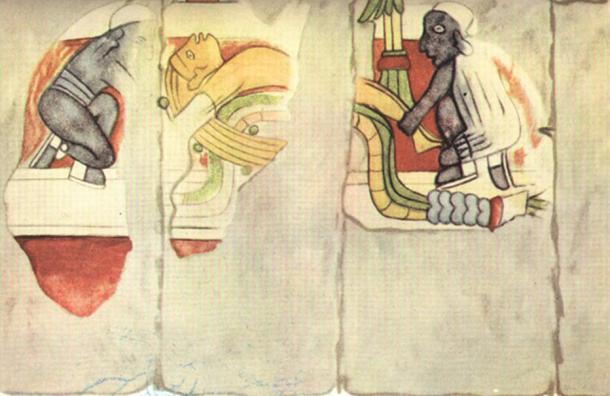

Comments
It’s a leap, via dubious conditioning, to call the white men of Aztec legends, Vikings. If you had to call them something other than just 'white men', ‘Atlantean’ would be a better fit.
But we know that when the Spaniards arrived on the scene, the natives did NOT have any stone-masonry or metal working skills or any equivalent industry. Obviously, a prior culture, perhaps an indigenous white race, in the Atlantean era (pre-Ice Age), was responsible for that. Like the ancient Greeks, a few would survive the Atlantis event and Ice Age that it caused, resettling the ruins, and existed there when the black-headed people crossed the Bering and entered the Americas. Legends suggest the two peoples did not get along when they met.
Nobody gets paid to tell the truth.
I went looking for the book:
"Probably composed soon after 1250, it has always been regarded as one of the most remarkable classical 'Sagas of Icelanders"..Eyrbyggja Saga has a complex structure in which eerie ghost-stories are interwoven with sober and realistic accounts of life in Iceland a thousand years ago. Its subtle and sophisticated narrative makes a searching examination of the internal conflicts which rapid social change arouses in any transitional society."
UM… That sounds like an esoteric exposition on medieval life combined with some spicy ghost stories. Hardly a factual treatice on nautical journeys. I WENT looking for the book beause I fail to see how a Viking ship could “trip and fall” past Florida and the islands plastered all over the Gulf of Mexico to land on the mainland. ...but TWO of them?? NAH!! Not gonna happen.
Incidentally, we DO have evidence of Viking settlements spreading across North America for centuries prior.. We just haven’t found anything definitive like a Viking ship in South Dakota or some such thing. I would submit that the ‘Mississippians’ may very well have been Viking or Celtic. They sure as hell weren’t Native American. ALTHOUGH, there has been a sprinkling of evidence to suggest that Phoenicians were all over the place as well. We know they had mapped the coastline.
Plus, it’s HIGHLY doubtful that their ships could have survived a trans-atlantic crossing.. especially after having gotten lost. You could easily convince me that the Vikings had set up Colonies up and down the coastline, since their boats were built for coastal travel. After hop-scotching down the coastline for a year or two, THEN they could end up in Mexico.
It also begs the question.. if the Aztec imprisoned / enslaved them.. how did a group of Vikings, lost and down on their luck in Mexico.. make it back to Scandinavia?! You’re suggesting it happened TWICE?? Come on now!
Also, I can’t get over the little hair-bob on the white peoples head, and the fact that the’re butt naked. I’m thinking islanders. Polynesian perhaps?
I find the idea of the Aztec leaders being black people HIGHLY intrigueing! We know from the Bible and our other very earliest written records that Africa was COVERED in advanced and noble Kingdoms. We’ve seen where many cultures were displaced by disease and plague.. I WONDER, if one of them may have followed the Phoenicians to the New World? I have never seen records of any of them having sea worthy vessels.. but it’s certainly possible!
I admit I know little about Mesoamerican history so I don’t have a scholarly response to this article but, after reading the comments, I’m more inclined to believe Dr. Winters than Willy. Dr. Winters gave references while Willy did not. To me, it sounds as if Willy has his POV and is bent on making everyone see his way and not willing to even entertain another POV
Sorry to rain on your parade “Doctor”, but your article, while decently written, contained little or no factual information. It seemed to be more of an opinion piece, which tried unsuccessfully to further your own deluded interperation of history.
Not to put too fine a point on it, you should seriously consider puting your talents to use in a different profession...writing. I would suggest Fantasy, or Fiction, as they both seem to be where your talents lay.
After reading your article, I had intended to take you to task, but after seeing your total embarrassment at the hands of another poster, I simply didn’t have the heart. It would be like adding insult to injury, and I am simply not that cruel.
R. Lee Bowers
so painting white people fighting black people is fairly meaningless. looks more like people in warpaint capturing people not in warpaint, or using colors to show "team" when painitng a conflict more than that the people looked that way
Pages